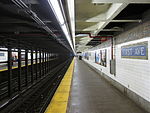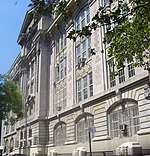Church of the Immaculate Conception and Clergy Houses

The Church of the Immaculate Conception and Clergy House at 406–412 East 14th Street between First Avenue and Avenue A in the East Village neighborhood of Manhattan, New York City were built in 1894–1896 by Grace Church, one of the most prominent Episcopal churches in the city at the time. The buildings were a free chapel – meaning there was no pew rent – called Grace Chapel and a connected Grace Hospital, which could serve 16 senior citizens and 10 children, and was physically connected to the chapel by a bridge, so that patients could be wheeled to services.They were designed by Barney and Chapman in French Gothic style. The firm was working at the same time on the Church of the Holy Trinity in Yorkville, which was also designed in the same style. Grace Chapel has stained-glass windows by Clayton & Bell and Henry Holiday. In 1943 both buildings were sold to the Roman Catholic Archdiocese of New York, and were converted for the use of the Immaculate Conception Church, founded in 1855, as a sanctuary and Clergy House.The buildings were designated a New York City landmark in 1966, and were added to the National Register of Historic Places in 1980.
Excerpt from the Wikipedia article Church of the Immaculate Conception and Clergy Houses (License: CC BY-SA 3.0, Authors, Images).Church of the Immaculate Conception and Clergy Houses
East 14th Street, New York Manhattan
Geographical coordinates (GPS) Address Phone number Website Nearby Places Show on map
Geographical coordinates (GPS)
| Latitude | Longitude |
|---|---|
| N 40.730833333333 ° | E -73.982222222222 ° |
Address
Immaculate Conception Church
East 14th Street 414
10009 New York, Manhattan
New York, United States
Open on Google Maps





